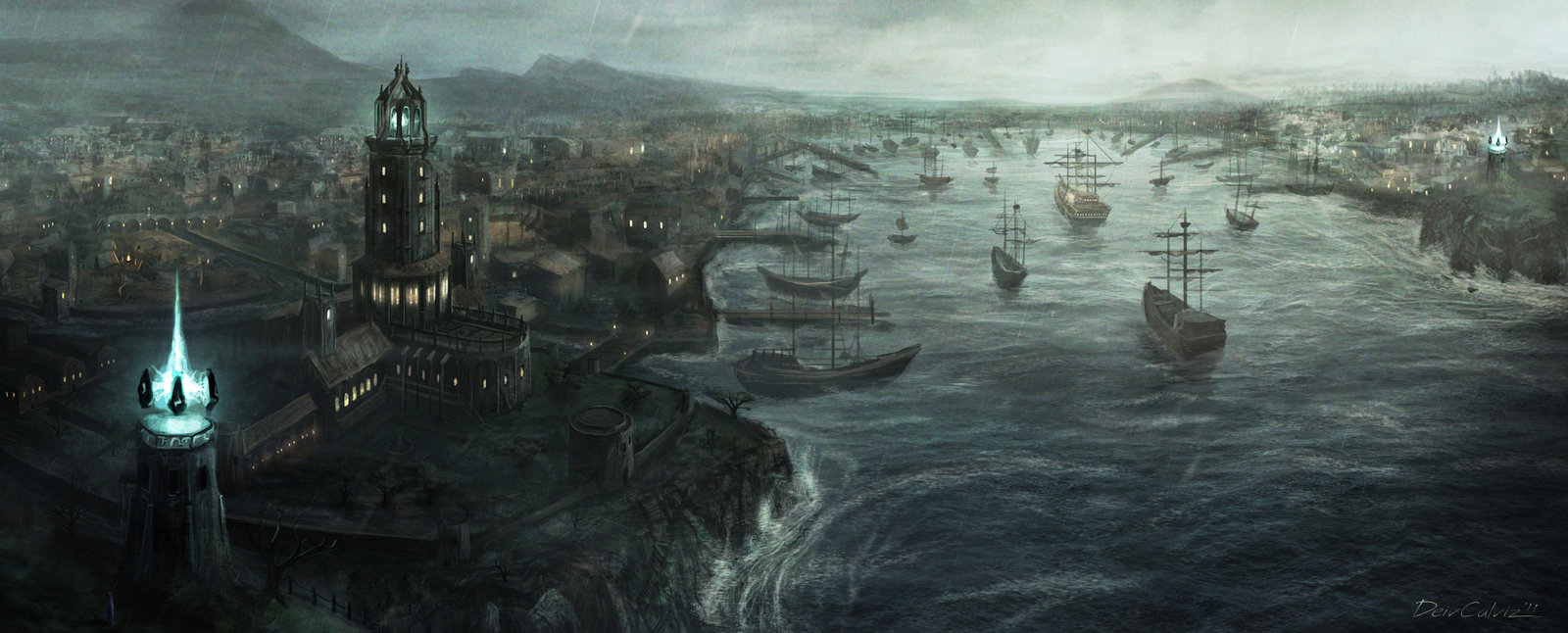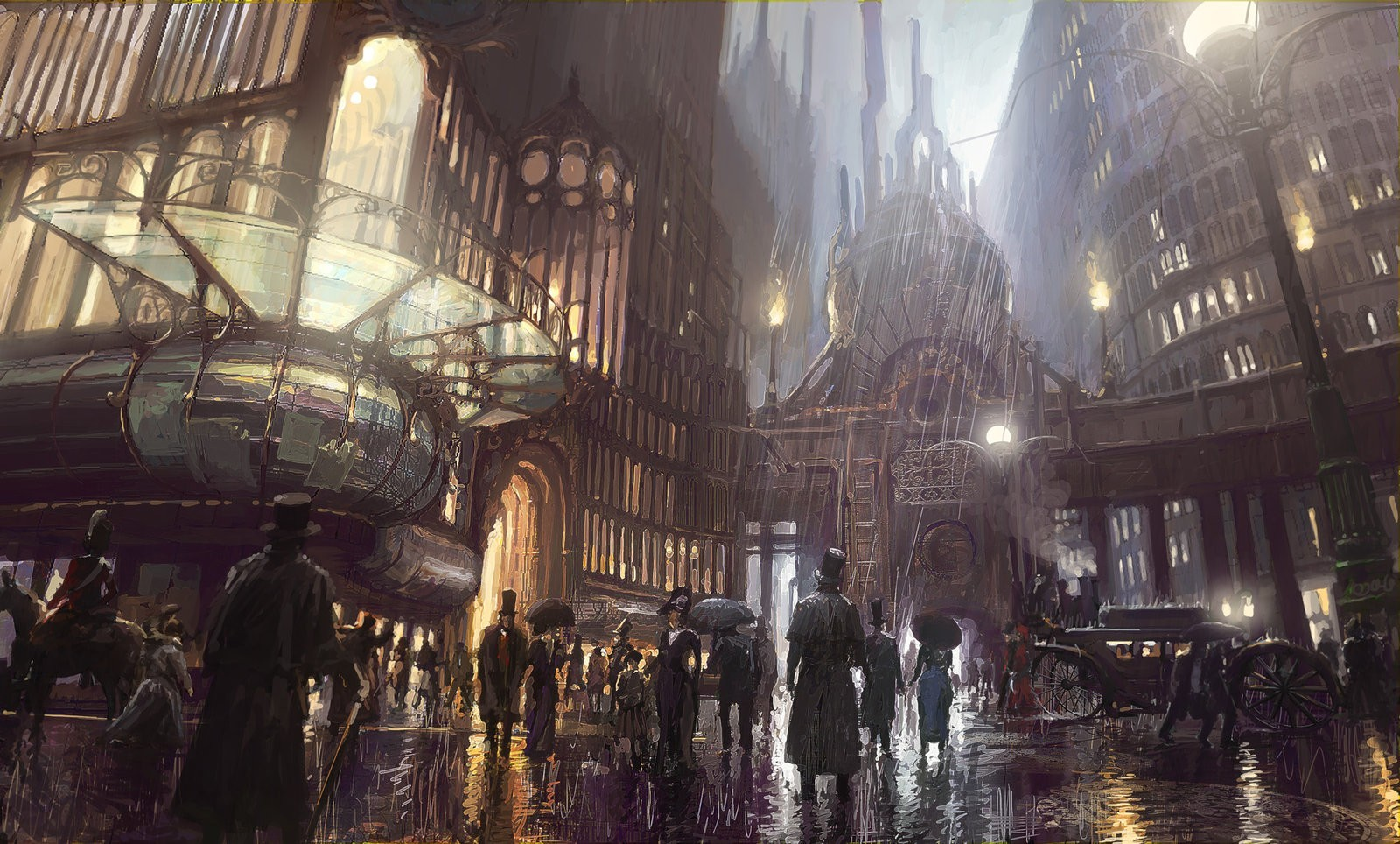Dinlirys
"A light snow falls fatefully through the night, as you glide silently through timeless forests towards the City of Shadow. Borne of freedom and individuality, yet fallen to notions of greed and division, Dinlirys was ruled by the free people for hundreds of years... until the discovery of arcane magic. Now, as the magocrats fabricated a throne and the position of Duke to fill it, this magic rules Dinlirys.
But the clock nears midnight, and this once free city's time shall come."
--Apollyon introduction.
--Dinlirys is built upon the Bay of Evandyr, and as such is a great center of trade. The Arcanist Society, the extension of the Conservatory from Golryon in Dinlirys, is at the edge of this Darklight Port.
Government
Dinlirys was, and constitutionally still is, ruled as a polity, a form of democracy where multiple parties have voting power based on their number of accepted citizens. This came about from the segregated boroughs that cropped up throughout the city, each disparate group of people desiring their own portion of the city, and each new fleeting faith wanting their own say. These parties of the polity, meet at the Republic Forum through their Councillor, and may vote upon issues with the power of their registered pledges. This has the added complexity of Summer and Winter parties. Any citizen may be part of any number of parties, but their vote is only counted once. Winter Parties rarely vote except for issues that concern their founding idealogy. For example, the Bedlam Rescue Coalition will only vote on any issues may work to save the borough that has fallen to plague in 906 AB. On the other hand, Summer parties vote on nearly every issue, meaning a citizen can only meaningfully be part of one.--The Viridian Theater, the center of culture, art, thaumaturgy, and the heart of Dinlirys.
Since the discovery of the layman's arcane magic in the Darkwater Chest, however, Lofus Stormborn and House Stormborn instituted a Duke in Dinlirys. Through persuasion, arcane manipulation, and gifts of charms and runic tattoos to nobles, Lofus acquired the support of enough Coalitions and parties and Unions to pay off an old debt to the Hao family, but also put his own puppet in control of his twinned city. The Duke of Dinlirys presides over the discussion of the parties, and can manipulate the voting process to push his own policy, which usually works. This is how Lofus took control of two cities in one year.
The largest Summer parties include the; Astral Coalition, Brick Coalition, Coalition of the Eternal Sage, Coalition of the Common Mage, Royalists, People's Coalition(Following the First Silver Revolition), and the Artificer's Coalition.
Important other parties are the; Shaper's Guild, Inheritance Dawn Coalition, Bedlam Rescue Coalition, and the currently outlawed Vox Populi, which are not recognized by the Forum due to claims of acts of terror.
--The City of Shadows. The Towers of a Thousand Cults. The Darklight Port. Otherwise known as a graveyard.
History
Built on the edge of the Bay of Evandyr, Dinlirys is the natural port of trade throughout the Bay, and most traders will sell their goods there after long voyages from Elysia, Jeria, or the Bronze Sea, rather than try and take their longboats or galleys upriver to Golryon or the Luna Balcan. The House Kyndarai, after some dispute with the Conservatory in 853 AB, decided to focus their Artificer's Coalition in Dinlirys, where they could craft and create their magitech without fear of local law, as it began cracking down harder on the populace due to their new magical abilities following Battle for the Fifth Ward. Devising elemental-bound seacraft, they now have galleys that use the power of the living elements to propel themselves to the speeds of the Stavik longboats or the Jerian wargalleys, allowing them to join the world in it's trade. Golryon and Dinlirys have been enemies for many years, peaking during Orion's War, when disputes over the Fallen Four of the Guardian Faith led to war when a large convent to those deities spawned forth Devils, Proteans, and Imperfections. The war ended three years later, with the Lunar Armistice, but the cities have been distrustful ever since. When the Hao family took control as the Dinliryan Duke, the attitude of the Dinliryian people towards Golryon polarized considerably. On one hand, they allow no one else in the world arcane magic, except their own people, and sharing it with Dinlirys, bringing not just themselves but also their brothers into the new age. On the other hand, this comes with the price of them manipulating the people into putting a figurehead of Gol much control over their city. There are those who riot claiming that Golryon is evil and must be ousted, and there are those that preach that Golryon is the twin of Dinlirys and they must band together against the growing threat of the Second Jeriec Empire, who serve the God-King Below and come to murder our children in the night. In truth, there are more opinions in Dinlirys than people.--Winter comes to the Silver Plains, beautiful, if still, in this gothic city. The gothic style is taken from ancient pieces of art of the local tribes that inhabited the land before the Feast of Hell, and Stavik influences from the northern sailors, while purposely refusing to accept styles from the majority of the people's Gol heritage, as a testament to their decisive separation.
Beliefs
All denominations of all worships are allowed freely in Dinlirys, as a consequence of it's founding by those seeking spiritual freedom. Cults to Avernus, the use of Apollyon, primal Animism, the Fallen Four, and dimension-worship are all found within the tiered streets of the City of a Thousand Cults. Additionally, sparsely known faiths such as the Salmon of Knowledge, the Ebon Shepard, the Chantry of the Burning Truth, and the Amaranthine Cross exist, and rarely extend outside the citizens of Dinlirys. As a direct contrast to Golryon, whose people believe firmly in the common struggle of mortality, and see themselves as all part of the greater whole, the Dinliryan prize and tout individualism. They see a person who can brave the dangers of the world outside their protection alone and who can make it in the cruel world higher than anything. They see a well-rounded mercenary far more vital to the state than a master craftsman who supplies arms for the city, and must buy from the local farmer. This is vital to the soul of the city, the renaissance idea that "a man can do all things if he will," and this as the pinnacle of mortal ability, rather than a society as a whole achieving those things, while a single person only playing a single part.--Ceradelta, the heart of Dinlirys' higher society, the Arcanist Society's major members, and the former location for five of the seven towers which now float above the city.
This idea is quickly losing traction in a city where magic and money and life expectancy are nearly synonymous, as well. The First Silver Revolution (862 AB) brought about the People's Coalition, forcing this city of individualism to turn their hearts to each other, and their cries for change and brotherhood were met with concrete changes. Such changes as the founding of public schooling, possession of charms becoming legal, the end of martial law, and the near-end of prisons were brought about because of this.
However, such changes were not enough, as the Second Silver Revolution (881 AB) came less than a generation after, and refused to be persuaded with talks of change within the system as is. The fate of this revolution would not be as bright, as where the sister city of Golryon, with it's imperialist tendencies, was formerly caught up in the Identity Crisis of 860, it was not so for this revolution. As the SSR becomes a serious threat to the Duchy and the Arcanist's Society, as well as the Conservatory's interests in the city, the new "temporary" government in Golryon sends hundreds of Wardens and arcane war machines to destroy the revolution, and strike from history the existence of the Silver Revolutions, going as far as to outlaw it's iconography.
Yet, with the beginning of the War of Manifest Mythopeia in 892, Golryon is again embroiled in conflict of it's own, and tensions yet rise in Dinlirys, as the clock nears midnight.
"Your preaching is mere moral violence, a threat of disaster. You claim we worship devils, greedy spirits, demons, and kings, while you worship naught but yourselves! Let us show you the holy will of that which you call unholy."
--Tobias Hao-Lin (before his Encounter with the Angel of the Summerlands), during the Tale of the Sutëir, in 419 AB.
Founded:
421 AB, by Tobias Hao-Lin and all those that followed their Rapture from Golryon.
Population
110,000 as of 852 AB, but with inhabited temporarily by near 130,000, including sailors, merchants, mercenaries, and travelers.
197,000 as of 897 AB, with temporary residents beringing it to nearly 220,000. (Includes almost 11,000 'permenant' refugees from the War of Manifest Mythopeia) Demographics:
25% human(60% Gol, 15% Reivantan, 25% Stav), 20% city elven, 16% dwarven, 12% jerian races, 8% forest elven, 6% high elven, 5% halfling, 2% wood orc, 2% gnome, 1% kenku, 1% desert elven, 1% other avernal, less than 1% other human.
421 AB, by Tobias Hao-Lin and all those that followed their Rapture from Golryon.
Population
110,000 as of 852 AB, but with inhabited temporarily by near 130,000, including sailors, merchants, mercenaries, and travelers.
197,000 as of 897 AB, with temporary residents beringing it to nearly 220,000. (Includes almost 11,000 'permenant' refugees from the War of Manifest Mythopeia) Demographics:
25% human(60% Gol, 15% Reivantan, 25% Stav), 20% city elven, 16% dwarven, 12% jerian races, 8% forest elven, 6% high elven, 5% halfling, 2% wood orc, 2% gnome, 1% kenku, 1% desert elven, 1% other avernal, less than 1% other human.







"a man can do all things if he will," and this as the pinnacle of mortal ability - If I had a character in the game this would be my city!